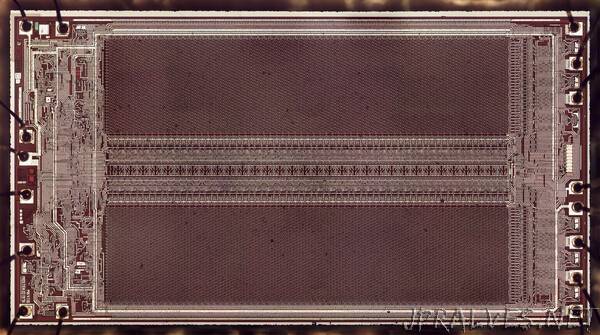
“Back in the late 1970s, the most popular memory chip was Mostek’s MK4116, holding a whopping (for the time) 16 kilobits. It provided storage for computers such as the Apple II, TRS-80, ZX Spectrum, Commodore PET, IBM PC, and Xerox Alto as well as video games such as Defender and Missile Command. To see how the chip is implemented I opened one up and reverse-engineered it. I expected the circuitry to be similar to other chips of the era, using standard NMOS gates, but it was much more complex than I expected, built from low-power dynamic logic. The MK4116 also used advanced manufacturing processes to fit 16,384 high-density memory cells on the chip.12
I created the die photo below from multiple microscope images. The white lines are the metal wiring on top of the chip, while the silicon underneath appears dark red. The two large rectangular regions are the 16,384 memory cells, arranged as a 128×128 matrix split in two. In between the two memory arrays are the amplifiers and selection circuits. The control and interface circuitry is at the left and right, connected to the external pins via tiny bond wires.
In dynamic RAM, each bit is stored in a capacitor with the bit’s value, 0 or 1, represented by the voltage on the capacitor.3 The advantage of dynamic RAM is that each memory cell is very small, so a lot of data can be stored on one chip.4 The downside of dynamic RAM is that the charge on a capacitor leaks away after a few milliseconds. To avoid losing data, dynamic RAM must be constantly refreshed: bits are read from the capacitors, amplified, and then written back to the capacitors. For the MK4116, all the data must be refreshed every two milliseconds.
The diagram below illustrates four of the 16,384 memory cells. Each memory cell has a capacitor, along with a transistor that connects the capacitor to the associated bit line. To read or write data, a row select line is energized, turning on the transistors in that row. The row’s capacitors are connected to the bit lines, allowing the bits in that row to be accessed.”
